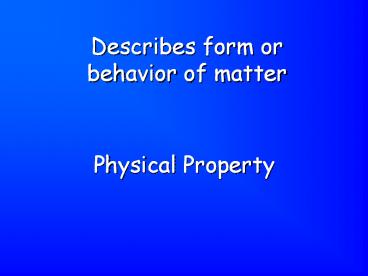Physical%20Property - PowerPoint PPT Presentation
Title: Physical%20Property
1
Physical Property
- Describes form or behavior of matter
2
Physical Properties
- Color
- Luster
- Malleability
- Conductivity
- Hardness
- Cleavage
- Phase at room temp.
- Vapor pressure
- Melting point
- Boiling point
- Heat of fusion
- Heat of vaporization
- Density
- Specific Heat Capacity
Physical constants!
3
Chemical Property
- Describes how matter interacts with other matter
reactivity
4
Chemical Change
- Identity Change
5
Examples of Chemical Change
- Synthesis, Decomposition, Single Replacement,
Double Replacement, Combustion, Polymerization,
Esterification, etc.
6
Monatomic
- One-atom Molecule
7
1 uppercase letter in formula
- Element
8
2 or more uppercase letters in formula
- Compound
9
Physical Change
- Identity stays the same
10
H2O(l) ? H2O(g)
- Phase changes are physical changes. Identity
stays the same.
11
2H2O(l) ? 2H2 O2(g)
- Identity changes.
- Chemical change.
12
Diatomic
- 2-Atom Molecule
13
Gases
- Take the shape volume of their container
14
Physical Constant
- Physical property expressed with a unit.
Independent of sample size.
15
Liquids
- Definite volume but no definite shape
16
Solids
- Definite volume definite shape
17
Compound
- 2 or more elements chemically combined
18
Element
- Cannot be broken down into anything simpler by
ordinary chemical or physical methods
19
Mixture
- Physical combination of 2 or more pure substances.
20
Pure Substances
- Elements Compounds
21
Mixtures
- Heterogeneous or Homogeneous
22
Distillation
- Physical method of separating mixture of 2 or
more liquids based on differences in boiling
points.
23
Solution
- Homogeneous Mixture. Liquid gas phase
solutions transmit light. Look translucent. Do
not separate on standing.
24
Suspension
- Heterogeneous Mixture. Scatter light. Look
cloudy. Need to be shaken or stirred. Separate
on standing.
25
NaCl(aq)
- Homogeneous Mixture. NaCl dissolved in water.
26
NaCl(s)
- Pure substance. NaCl in the solid phase.
27
Variable Composition
- Mixture
28
NaCl(l)
- Pure substance. NaCl in the liquid phase.
29
NaCl(g)
- Pure substance. NaCl in the gas phase.
30
Homogeneous
- Uniform, constant, the same throughout.
31
Heterogeneous
- Non-uniform composition.
- May see regions that look different. May be more
than 1 phase present.
32
Always Homogeneous
- Pure substance Element or Compound
33
Filtration
- Physical separation technique used to separate
heterogeneous mixtures. Based on differences in
particle size.
34
Sorting
- Physical separation technique used to separate
heterogeneous mixtures. Based on differences in
appearance.
35
Definite Unique Properties
- Pure substance. Element or Compound.
36
Broken into components by chemical decomposition
reaction
- Compound
37
Definite Composition
- Pure substance. Element or Compound.
38
Separated by physical technique
- Mixture
39
Triatomic
- 3-atom Molecule
40
May be homogeneous or heterogeneous
- Mixture
41
Density, melting point, boiling point
- Examples of physical constants
42
Law of conservation of matter
- Mass Before Mass After
43
Given X 2Y ? Q 3Z
- Mass Before Mass After
The equation is a distractor. 44 128 32
grams Z 140 g.
When 44 grams of X react completely with 128
grams of Y, 32 grams of Q are produced. How much
Z will be made?
44
No new properties. Properties are a mix of
properties of components.
- Mixture
45
C6H12O6(s) ? C6H12O6(aq)
- Equation represents dissolving. Dissolving is a
physical change.
46
Physical Properties
- Used to identify substances.
47
Atoms can vibrate back forth about a fixed
position.
- Solid state
48
Phys. M.
Chem.
(solutions)
(suspensions)
Mixtures ? Separated by physical
methods. Compounds ? Separated by chemical
methods.
49
Ways to separate heterogeneous mixtures
- Sorting
- Filtration
- Crystallization
- Evaporation
- Distillation
- Chromatography
- Differences in density
- Differences in magnetic properties
- Differences in solubility
50
Change of phase terms
Liquid to gas
- Evaporation
- Freezing
- Melting
- Condensation
- Boiling
- Deposition
- Fusion
- Vaporization
- Sublimation
Liquid to solid
Solid to liquid
Gas to liquid
Liquid to gas
Gas to solid
Solid to liquid
Liquid to gas
Solid to gas
51
Crystallization and Solidification
- More change of phase terms.
- Liquid to Solid.
52
Substances that sublimate
- CO2 and I2
53
Molecules are relatively far apart from each
other can move from place to place.
- Gas Phase
54
One substance dissolved in another substance
- Solution
55
Phase at room temperatrue
- Physical property
56
Molecules are pretty close, but have enough room
to slide or tumble past each other.
- Liquid Phase
57
Chromatography
- Physical separation technique based on
differences in intermolecular forces.
58
Vapor
- Gas phase of a substance that is usually a liquid
at room temperature.
59
Names for some chemical changes
- Corrosion, Decomposition, Neutralization,
Burning, Fermentation
60
of atoms of each element before of atoms of
each element after
- Law of Conservation of Matter
61
Percent
- Part X 100
Whole
62
1 upper case letter in formula
- Element
63
Cutting, Crumpling, Tearing, Pulling into wire,
Hammering into sheet
- Examples of physical changes
64
Phase Changes
- Physical changes
65
Dissolving
- Physical Change
66
Evidence of Chemical Change
- Production of heat light
- Formation of a gas (bubbles)
- Formation of a precipitate
- Change in identifying properties
67
Opposite of dissolving. Solid comes out of
solution.
- Precipitation
68
Particles arranged in a regular geometric pattern.
- Solid
69
Endothermic
G
Potential Energy
L
Exothermic
S
70
Particle Diagrams
Pure substance units the same. molecules of a
triatomic compound.
?
?
?
?
?
?
?
?
?
Mixture units differ. monatomic element,
diatomic element, triatomic compound.
?
?
?
?
?
?
?
?
?
?
?
?
?
71
Mixture
Pure Substance
Pure Substance
Pure Substance
72
Compounds vs. Mixtures
Always homogeneous May be homogeneous or heterogeneous
Definite composition Variable composition
Definite unique properties No unique properties
Separated into elements by chemical reaction Separated into components by physical methods































